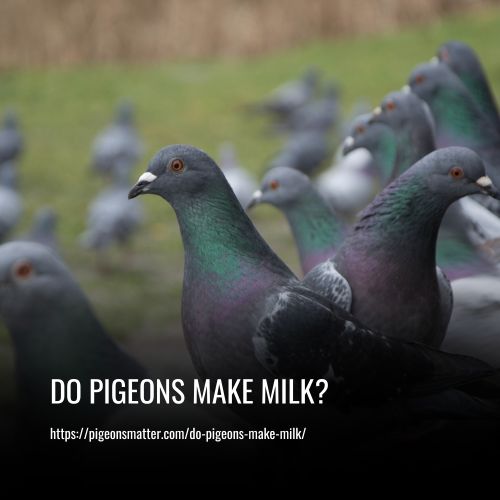Pigeons do produce a substance called pigeon milk, which is used to feed their young, called squabs. Pigeon milk is a gruel produced in the parents’ crop and is regurgitated into the mouth of the squab. It provides the necessary nutrition for the baby pigeons to survive.
In the case of hand-rearing baby pigeons, a similar gruel made of seeds, minerals, and water can be used as a substitute for pigeon milk. However, it is not actually secreted from the human crop and is fed to the baby pigeons using a different method, such as a rubber catheter.

What Is Pigeon Crop Milk
Crop milk is a nutritious substance that is semi-solid and contains significant amounts of fat and protein. It contains immunity-enhancing factors, antibodies, and antioxidants that make it extremely beneficial for the growth and development of baby pigeons. Pigeon crop milk is particularly rich in protein and fat, making it a superior source of nutrition for squabs. It is typically produced a few days before the eggs are due to hatch and is consumed by the baby pigeons for about 7-10 days.
Research indicates that squabs that consume pigeon crop milk exhibit a 16% increase in weight and overall health compared to those that do not. This highlights the importance of this substance in ensuring the proper growth and development of baby pigeons.
It is worth mentioning that while both parent pigeons are capable of producing pigeon milk, the quantity produced is insufficient to adequately feed three squabs. That’s why it’s common for clutches to be limited to two to ensure that each squab receives enough nutrition to thrive.
Is Pigeon Milk Really Milk
Pigeon milk is not like milk from mammals, but rather a crumbly excretion containing high levels of protein and fat. It is produced from fluid cells in the crop of the pigeon, a sac-like pocket that serves as a food storage area under the gullet. The substance known as “Pigeon Milk” is referred to by this term worldwide, despite its misleading and uncommon name.
Despite the name, pigeons do not produce milk as mammals do. Instead, they produce a specific type of milk for their baby squabs that is high in protein and fat but does not come from mammary glands like mammalian milk.
It is important to note that both pigeons and mammals have prolactin hormones that can cause lactation in birds, but the milk produced by pigeons is not the same as mammalian milk. Understanding the differences between these types of milk can help bird owners provide the best care for their feathered friends.
Crop Milk Nutrition Composition
Crop milk is a highly nutritious substance produced by birds that is comparable to mammal milk. It contains immunity-enhancing protein, fat, antioxidants, minerals, antibodies, carbohydrates, and other nutrients. The protein content in crop milk is particularly high, making up 50 to 60% of its composition. Additionally, crop milk contains a variety of minerals such as Sodium, Calcium, and Potassium that are essential for the growth and development of baby birds.
Research has indicated that baby birds provided with crop milk tend to have a weight that is 16% higher compared to those that are not given this milk. This is likely due to the high nutrient density of crop milk, which provides the necessary nutrition for the growth and development of baby birds. However, it is important to note that the nutritional density of crop milk may vary depending on the bird species.
Importance Of Crop Milk
Parent pigeons produce enough crop milk to feed two hatchlings, which is why two eggs are typically laid. It is uncommon for a female pigeon to lay three eggs. If one of the hatchlings dies, the remaining one will receive all the crop milk and develop to be stronger and healthier than if it had to share with a sibling.
The survival of a young pigeon without crop milk is unlikely. Research has shown the importance of crop milk in the development and survival of pigeon hatchlings.
Do Pigeons Have Nipples
Pigeons do not have nipples, unlike mammals, as they do not use breasts to feed their young with milk. Instead, pigeons have a muscular pouch inside their digestive system that produces a secretion called crop milk, which is used to feed their squabs.
While birds do have breasts, they are not used for milk production. They are used for flight purposes, as the pectoral muscles in the breast help birds to fly. Therefore, pigeons do not use their breasts for feeding their young, but for flying. So, if you ever wondered why pigeons do not have nipples, it’s because they have a different method of providing nutrition to their offspring.
How Do Pigeons Feed Their Babies
Feeding baby pigeons or squabs is an interesting process that involves both parents regurgitating crop milk for the first few days after hatching. During the initial four days after hatching, baby pigeons are fed regurgitated crop milk by both parents. This process begins within two hours of birth and continues for around 7 to 10 days. Following this period, the parents start to feed the young pigeons a combination of crop milk, seeds, and other types of food.
Once the squabs reach their 10th day, they begin consuming invertebrates, fruits, seeds, and other adult pigeon food. However, they still rely on their parents to feed them and will make a peeping call when they are hungry.
During the initial days, squabs require food 3 to 4 times a day, which decreases to 2 times a day after the 7th day. It’s important to ensure that the baby pigeons are receiving proper nutrition to ensure their healthy growth and development.
Is Crop Milk Necessary For Baby Pigeons
Crop milk is a crucial source of nutrition for baby squabs, providing a wide range of essential nutrients.
1. Protein
Crop milk is high in protein, providing the building blocks necessary for the growth and development of baby squabs. This protein is easily digestible, allowing the squabs to efficiently utilize the nutrients for growth.
2. Fat
Crop milk is also high in fat, which provides energy for growing squabs. This fat is essential for the development of their nervous system and brain.
3. Carbohydrates
Crop milk contains carbohydrates, which provide energy for the squabs to grow and develop. These carbohydrates are easily digestible, allowing the squabs to efficiently utilize the nutrients for growth.
4. Vitamins and Minerals
Crop milk is rich in vitamins and minerals, including calcium, phosphorus, and vitamins A, D, and E. These nutrients are essential for the development of strong bones, healthy feathers, and a robust immune system.
5. Antibodies
Crop milk contains antibodies that help protect the squabs from disease and infection. These antibodies are passed on from the parent birds and provide the squabs with a strong immune system.
Overall, crop milk is a highly nutritious substance that is essential for the growth and development of baby squabs. It provides a wide range of nutrients, including protein, fat, carbohydrates, vitamins, minerals, and antibodies, that are vital for their health and well-being.
6. Bacteria Availability For Digestion
Baby pigeons consume crop milk, which contains beneficial bacteria that help them develop a strong and healthy digestive system. While crop milk does contain some bacteria, it is essential for the growth and development of baby pigeons. By consuming crop milk, baby pigeons can thrive and develop into healthy adult birds.
Can You Drink Pigeon Milk
While the idea of drinking pigeon milk may seem intriguing, it is not currently possible to do so. This is because the substance produced by pigeons, known as crop milk, is different from mammal milk in its composition.
Crop milk is produced in a pouch located in the pigeon’s stomach or throat, and cannot be easily extracted. Even if it could be obtained, the resulting substance is not drinkable in its natural form. It is a nourishing substance that contains fat, antioxidants, and immune-enhancing proteins, but it is not meant for human consumption.
Attempting to drink pigeon milk could actually be harmful to your health. Therefore, until a safe and practical way of producing and consuming pigeon milk is developed, it is best to stick to other sources of nourishment.
FAQs
Unlike mammalian milk, crop milk is not produced by mammary glands. Instead, it is a product of the birds’ crop glands and contains higher levels of protein and fat, making it a crucial source of nutrition for pigeon chicks.
It’s a common misconception that birds give milk to their young. Birds do not produce milk similar to that of mammals. Only three species of birds, namely pigeons, flamingos, and penguins, can produce a type of milk-like substance. This crop of milk is used to feed their babies during the initial stages of hatching. It’s important to note that this bird milk is entirely different from mammal milk in terms of its composition and production. So, while some birds do produce a milk-like substance, it’s not the same as mammal milk.
Pigeon parents typically feed their young crop milk for the first few days after hatching. As the chicks grow, their diet gradually transitions to solid food, and they become less reliant on crop milk.
The production of crop milk is an essential factor in the successful rearing of pigeon chicks. It provides them with the necessary nutrients for healthy growth and plays a pivotal role in their survival.
If you’re looking to provide your baby squabs with a crop milk dietary supplement, there are many options available in the market. For example, you can easily purchase Rohn Fried Crop Milk (600g) from Amazon, which comes in a convenient powder form for easy storage and use. This crop milk supplement is designed to optimize breeding results and contains high levels of animal protein components and amino acids to support your baby squabs’ growth and development.
Conclusion
While it may seem a bit odd that pigeons produce milk, it is in fact true. This is a fascinating example of nature adapting and evolving in unique ways and serves as an inspiration for us all to explore the unknown.
It shows us that there can be more to discover out there and to never give up when things are difficult—especially when something as incredible and unusual as pigeon milk may just be waiting around the corner.


